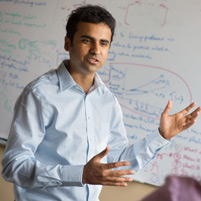Information-Friction

Pulkit Grover
Pulkit Grover knows a good theory doesn't matter much if it falls apart in practice.
At Carnegie Mellon University, this Assistant Professor of Electrical and Computer Engineering works with researchers who can put his theories to the test.
Grover recently was awarded a five-year, $600,000 National Science Foundation CAREER Award, which he'll use for research aimed at reducing energy in data center communication networks.
"At the end of the day, how do paradigm changes in science happen? If you look back at a lot of great people like Claude Shannon, the father of information theory, or Alan Turing, the father of computer science, they're from the 1940s, an era when many scientific theories were laid out that we still use today," Grover said. "The reason for that is all of these really great theorists were forced to interact with the real world. They came up with models and theoretical foundations on which the digital era is built."
Grover's work is focused on revising Shannon's theory, which helped found the electronic communications age, to accommodate today's technology.
"Shannon's theory was motivated by applications during the time of space research. Sputnik 1 was about to be launched. It was the time of the television, the telegraph and the telephone. At that time, we were only interested in communicating long distances," he said.
But the story has changed.
"Now we have data centers, which have these rooms full of computers separated by just meters and that are connected to each other using very high speed links. In brain-machine interfaces, where we are looking at biomedical implants that you might put inside the brain, communication is on the order of centimeters. Or think of the communication between a pacemaker and an outside entity," he said.
Grover coined the term "Information-Friction" to describe the energy needed to move information in circuits.
"We arrived at this concept by trial and error. Through experimental collaborations, we found that wires in circuits consume a lot of energy. Today, the energy required to move information on these circuit wires at transmitter and receiver can be the dominant chunk of total energy," Grover said.
"The NSF grant is for really understanding the fundamentals of how to reduce energy in today's short-distance communication systems. So whether it's big data computing, or cell phone communications, biomedical implants or brain-machine interfaces, all of these systems require a lot of energy," he said.
Grover's goal is to understand how communication systems and computation systems interact and how to minimize the total energy required for transmitting and receiving information. He predicts that energy consumption can be reduced by a factor of 10, or more, in some of these systems.
Grover is one of more than 100 CMU faculty working together across disciplines to solve some of the world's most challenging energy problems through the university's Wilton E. Scott Institute for Energy Innovation. Using CMU's expertise in integrated systems, problem-solving, and an understanding of the intersection of energy and public policy, the work of the institute concentrates on energy efficiencies and reliability, as well as smart operations, materials and processes.
His work also is part of CMU's Center for Silicon System Implementation, headed by Shawn Blanton.
Grover said his belief that good theoretical research must involve building practical systems borders on the religious.
"It's a process in which you fail a lot more, but at least you know you're failing, and you go back and you make the product better and better until it succeeds," he said.
Grover said it's been helpful to him that CMU is such a collaborative place.
"I wasn't explicitly thinking of questions in neuroscience or neuro-engineering before I joined CMU, and I think having all of these colleagues here, who are really good friends now, as well as the wonderful Center for Neural Basis of Cognition (CNBC), has been very helpful in expanding my horizons and understanding," he said.
"Collaborations with Xin Li, Jeyanandh Paramesh, Peter Gilgunn, Soummya Kar, Jeff Weldon and many others in Electrical and Computer Engineering, and neuroscientists at the University of Pittsburgh, have led to even more exciting ideas of going beyond Shannon theory that we are investigating," Grover said. "Suddenly, the world has become much more interesting."
Related Links: Scott Institute | College of Engineering | Read press release
